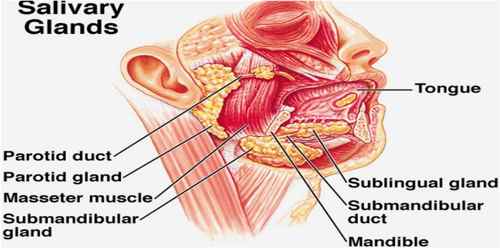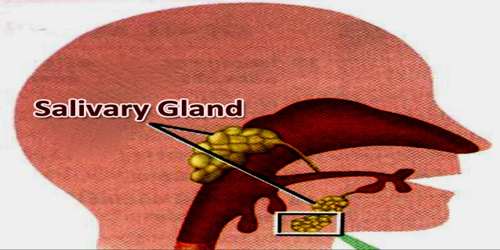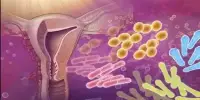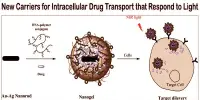Salivary Gland
Definition
Salivary gland is a gland in terrestrial animals that secretes saliva. In humans, three pairs of large glands, which include the parotid glands, secrete saliva into the mouth. It is also known as ptyalin. It also helps break down carbohydrates and lubricates the passage of food down from the oro-pharynx to the esophagus to the stomach.

There are four pairs of salivary glands:
- The parotid glands are located between the ear and the jaw.
- The submandibular glands are located under the jaw.
- The sublingual glands are located on the floor of the mouth under the tongue.
- The buccal glands are not shown in this picture. They are located in the mucous membrane lining the cheeks and mouth. These glands produce only a small amount of saliva.
Structure and Functions of Salivary Gland
There are three pairs of salivary glands – the parotid, submandibular and sublingual. This secret saliva which begins the process of digestion in the mouth. The parotid glands lie below and slightly in front of each ear. They are the largest of the salivary glands. The submandibular glands are situated just under the cover of the angle of the mandible.
The sublingual glands lie in the anterior part of the floor of the mouth between the tongue and mandible. They pour their secretions directly into the mouth. The digestive juices secreted by these glands are commonly called saliva.
This is a fluid consisting of 90% water and a digestive enzyme ptyalin (salivary amylase). The carbohydrate gets partly digested due to the action of saliva. The saliva also contains mucin and a small quantity of calcium salts.

Nerve Supply: The acini, myoepithelial cells and the blood vessels of salivary glands are well supplied by sympathetic and parasympathetic nerve fibers.
Parasympathetic: These fibers are important because they are known as the secretomotor fibers to the salivary gland. On stimulation, they bring about (1) secretion from the glands and (2) increase the blood flow to salivary glands.
There are two nuclei in the medulla known as superior and inferior salivary nuclei. From the superior salivary nucleus, the secretomotor fibers for submandibular and sublingual glands take origin.
Salivary glands are a group of organs secreting a watery substance that is of utmost importance for several physiological functions ranging from the protection of teeth and surrounding soft tissues to the lubrication of the oral cavity, which is crucial for speech and perception of food taste. Salivary glands are complex networks of hollow tubes and secretory units that are found in specific locations of the mouth and which, although architecturally similar, exhibit individual specificities according to their location.
Other Animals
The salivary glands of some species however, are modified to produce proteins; salivary amylase is found in many, but by no means all, bird and mammal species (including humans, as noted above). Furthermore, the venom glands of venomous snakes (colloquially called poisonous snakes), Gila monsters, and some shrews, are modified salivary glands. In other organisms such as insects, salivary glands are often used to produce biologically important proteins like silk or glues, and fly salivary glands contain polytene chromosomes that have been useful in genetic research.
Reference:
















